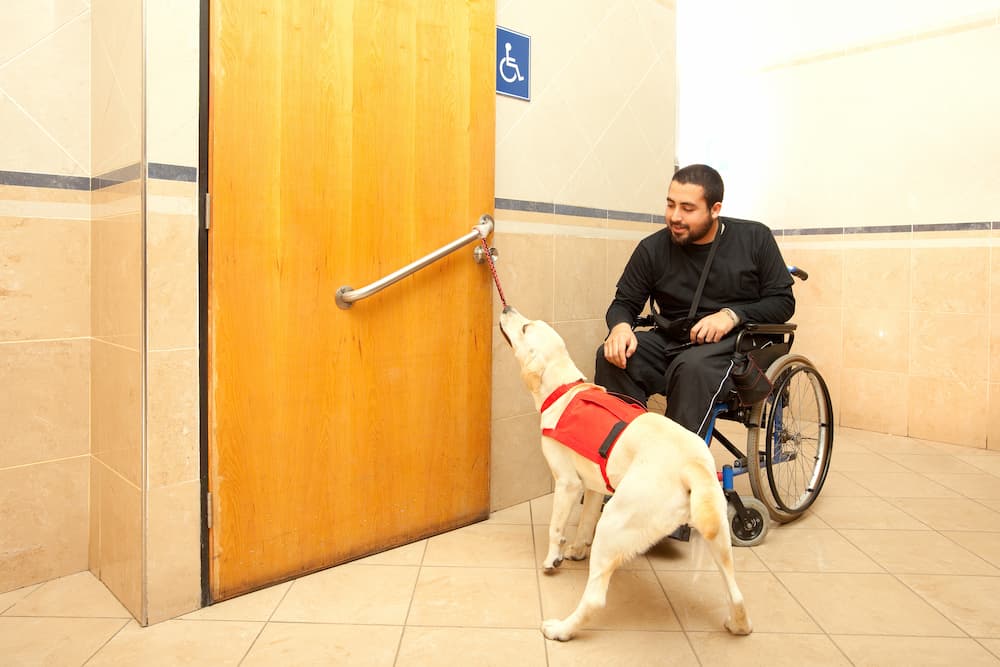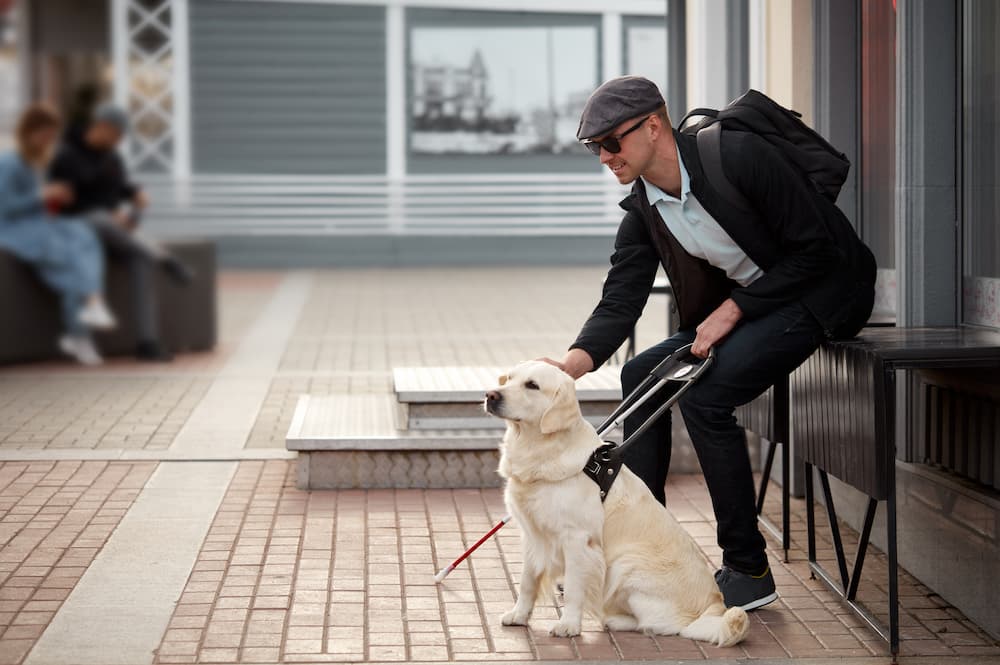Animals can help humans with disabilities in many ways, according to The Humane Society of the United States. For example, service animals can be trained to assist people with physical disabilities, such as blindness or mobility impairments.
Other assistance animals, like certain dogs and horses, can provide emotional support to people suffering from depression or anxiety.
In this blog post, we’ll explore how assistance animals can help humans with disabilities lead happier and more independent lives. Are you interested in learning more? Keep reading!
Animals Helping Humans With Disabilities
People with disabilities can get many therapeutic benefits from spending time with animals.
A service animal, such as a dog, can play a crucial role in oncoming seizure detection for people with disabilities with potentially life-threatening symptoms, such as epilepsy.
A study showed that service dogs could alert their owners up to 45 minutes before a seizure occurred. This gave the individuals time to take medication or get to a safe place. So, this is how seizure response dogs can help people.
Another way animals can help people with disabilities is by providing emotional support. Moreover, animals can offer companionship and unconditional love, benefiting people suffering from loneliness, anxiety, or depression.
Another study found that people who interacted with therapy dogs had lower levels of cortisol (a stress hormone) and felt more relaxed and happy than those who did not interact with the dogs.
How Are Animals Trained To Help Humans?
From service animals to providing companionship, animals have been helping humans with disabilities for centuries. Let’s take a look at the type of animals that are trained to help humans with disabilities.
Service animals
Service animals, like dogs, are specifically trained to perform certain tasks to assist humans.
The National Service Animal Registry says that animals such as dogs and miniature horses are trained in a way that they can assist those people with physical disabilities, serious mental illnesses, or other potential hazards in life. The disabilities act further added some tasks that these animals can perform.
They can do “major” tasks, including bathing, dressing, and shaving. Moreover, they also assist in preparing meals, going out for walks, pulling wheelchairs, and performing manual, laborious work.
To become a service animal, the animal must undergo rigorous training. The process usually takes about two years, and the animal must be able to perform specific tasks on command. You can take help from training centers that train dogs.
While having a service animal may greatly improve one’s quality of life in several ways, including increased independence, safety, and effectiveness in social and professional situations, the financial investment required to get one can be substantial.
How do service animals help?
A service dog might be trained to:
- Retrieve objects for a person who uses a wheelchair
- Press an elevator button for a person who has difficulty using their hands
- Provide balance and support for a person who has trouble walking
- Alert a person with hearing loss when someone is calling their name
- Calm a person during a panic attack or anxiety attack
Therapy animals
Animal-assisted therapy animals are not trained to perform specific tasks like service animals. They provide emotional support and companionship to people in hospitals, nursing homes, schools, and other places.
Therapy animals are pets that have been socialized and taught to help people cope with stressful situations. They are different from service dogs and ESAs.
Most of the time, therapy animals may be found in places like hospitals, nursing homes, education institutions, and disaster areas.
There are many different kinds of therapy animals, but the most popular type is the therapeutic visitation animal. Animal-assisted therapy animals typically spend the day at a different location, like a detention facility, with people who miss their own pets.
How do therapy animals help?
Therapy animals can help people in the following ways:
- Several studies have shown that interacting with pets improves mental well-being and reduces the symptoms of psychiatric diseases. Extensive studies on pets have shown that they may improve the emotional well-being of their owners and be a source of comfort in times of stress.
- Pets, especially dogs, have been shown to positively affect human health by lowering stress and blood pressure and boosting joy. Those suffering from anxiety have found them to be beneficial in their treatment. It’s for this reason that animal-assisted therapy is important.
- Maintaining emotional stability is challenging for those with disabilities. However, the presence of a therapy animal can help those in such situations by combatting emotional breakdowns and maintaining a positive state of mind.
Emotional support animals (ESAs)
Unlike service animals, emotional support animals (ESAs) are not trained to perform specific tasks. They provide companionship, relieve loneliness, and sometimes help people with anxiety or depression. An ESA can be any animal, but dogs and cats are the most common.
To qualify for an ESA, you must need a letter from your licensed mental health care professional stating that you have a mental illness or emotional disability and that the animal is necessary for your treatment.
There are indeed advantages to using an ESA. Even if an apartment building has a strict no-pets policy, a person with a valid ESA certification can always bring the animal with them. It also covers domestic airplane cabin travel for your ESA at no cost and removes the need to pay a monthly pet fee.
How do ESAs help?
The following are some of the benefits that ESA provides to people:
- Individuals with a disability may find it difficult to experience love from others, but having an ESA can help. An ESA’s companionship and unconditional affection can help those who have trouble finding these things in human relationships.
- Having an ESA is helpful, but integrating them into specific therapy models can be much more beneficial.
- Managing day-to-day life activities is difficult when you have a disability, especially when your disability makes you feel sad or anxious about something. ESAs are ready daily to help their owners maintain emotional stability.
What Types Of Disabilities Can Service Animals Assist With?
Intelligent and highly trained, service dogs can perform a wide range of tasks to make human lives easier. There’s no full list of how assistance dogs and other animals support humans, but here are some of the most popular.
Hearing impaired
These service animals help deaf or hard of hearing people by letting them know when there is a loud noise, such as smoke alarms, a doorbell, an alarm clock, or a baby crying. An animal that hears a noise will touch its human owner and direct them to approach.
Diabetes patients
The Hypo Hounds train dogs to sense chemical changes in their owner’s blood sugar, giving them a sense of independence and security. Dogs can alert their pet owners to harmful spikes and drops in blood sugar levels by detecting subtle odor changes linked with hyperglycemic and hypoglycemic episodes in diabetics.
Extreme sensitivity to allergens
Dogs, specifically the peanut detector dogs, with the ability to identify allergens can be useful for those with severe reactions to foods like peanuts or gluten. This ability can save the lives of people who have severe allergies.
Visually impaired
Persons with vision impairments regularly make use of guide dogs. Labrador Retrievers are commonly used as guide dogs because they have a mild temperament and size range. Typically, guide dogs will wear a U-shaped harness that will allow their human companion to instruct them in various ways. It is important to train guide dogs so that they can help in any specific situation.
Conclusion
Although animals cannot cure disabilities, they provide a sense of normality and comfort to those who struggle with them daily. Animals offer support in the form of companionship, unconditional love, and a nonjudgmental presence often missing from the lives of people with disabilities.




